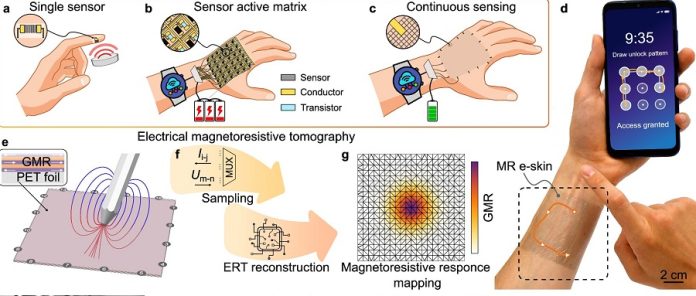
Imagine being able to control your smartphone underwater, or move through virtual worlds just by waving your hand—no wires, no touching, and no bulky gear.
This could soon be real thanks to a new kind of electronic skin, or “e-skin,” developed by researchers at the Helmholtz-Zentrum Dresden-Rossendorf (HZDR).
This new e-skin is ultra-light, thin, transparent, and even breathable—letting air and moisture pass through so your real skin underneath stays comfortable.
Most importantly, it can sense and track magnetic fields with just one global sensor, making it much simpler and smarter than older technologies.
E-skins are artificial layers that work like real skin. They help robots feel their surroundings and can even be used to restore lost senses in people.
Some e-skins can detect chemicals or magnetic fields, but the more advanced ones often need many sensors and large batteries, which makes them heavy and hard to use.
To fix this, the HZDR team built their e-skin using a super-thin, flexible membrane instead of hard materials.
This special material includes a magnetosensitive layer that changes its electrical resistance when it detects a magnetic field.
A central computer then reads these changes and figures out exactly where the magnetic signal came from—just like how your brain processes touch on your skin.
“This is more like how real human skin and the brain work together,” explains researcher Denys Makarov. “Instead of using lots of sensors, we use one smart layer and one brain-like processor.”
The team also used a medical scanning technique called tomography, which combines many small signals to create a clear picture.
This allowed them to pinpoint magnetic signals even though the signal contrast is low—something many thought wasn’t possible with magnetic materials.
This new e-skin can be used in many ways. It can recognize patterns written with a magnetic pen, allow people to interact with virtual reality without touching anything, or even help operate smartphones in tough environments like underwater or in the snow—just by using a magnetic patch on a glove.
Because magnetic sensors are less affected by other electronics, robots using this e-skin could also work better in tricky environments.
This new kind of electronic skin doesn’t just sense magnetism—it opens a whole new way for humans and machines to connect.



